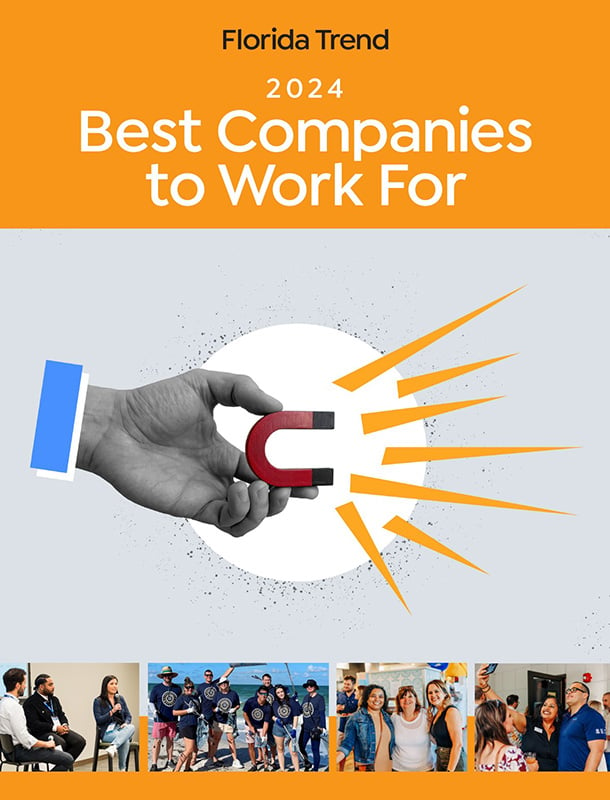You can never get too comfortable — even when everything seems to be going perfectly. At any point, your business could be affected by a natural disaster or some other event that’s completely out of your control.
When everything is running smoothly, it’s easy to get lulled into a false sense of security. Unfortunately, even if you are doing everything right, there is always a chance — no matter how small — that something could go horribly wrong.
No matter where your business is located, you will never be 100 percent insulated from disaster. Floods, fires, pandemics, hurricanes and cyberattacks all have the potential to wreak havoc on your business and the customers you rely on.
If you’ve lived in Florida for more than a year or two, you know how important it is to be prepared. So, before disaster strikes:
KNOW WHAT YOU COULD BE FACING
In Florida, your contingency planning should begin with hurricanes. That’s not to say that you should ignore other potential threats. But we know how much damage a Category 5 storm can do to large chunks of the state.
Good planning means taking precautions long before a hurricane has your business in its “cone of uncertainty.” Winter and spring are great times to install impact resistant windows; map evacuation routes; stockpile water, batteries, canned goods, and other essentials; and backup any important computer files to store off-site or on the cloud for easy access.
BUILD CONTINGENCY PLANS
No matter how much you plan for it, a hurricane could still flatten your workplace. If that happens, how will you communicate with customers and suppliers? Can you support your employees working from home? What if employees need to home-school their children or care for elderly family members?
Remember, too, that it’s not just storms you need to worry about. There could be violence and civil unrest; sinkholes and lightning strikes; train derailments and toxic chemical spills. Maybe even another pandemic. Regardless of what the event is, you should strive to be ready well in advance of any disaster.
PROTECT YOUR PEOPLE, THEN YOUR PROPERTY
Buildings can be replaced, people can’t. Keep in mind that you and your employees could need to be evacuated to safer ground. Plan for that. Consider putting together a list of directions to local shelters, hospitals, emergency services and post emergency phone numbers and contacts within easy reach of all employees. And don’t rely on your computer system to store this data. Keep printed copies on hand — in case you lose power or access to your computer.
GETTING BACK TO NORMAL
After the immediate threat subsides, you will obviously be eager to get back to work and make money as quickly as possible. Unfortunately, that’s often easier said than done — particularly if you have to wait weeks for your insurance claim to be processed.
Having repairs to make and employees to pay may send you scrambling for assistance. And help is there if you know where to look.
After a disaster strikes the state, members of the Florida SBDC Network serve as primary contacts for processing and submitting the paperwork needed to secure short-term, zero-interest Florida Small Business Emergency Bridge Loans.
For businesses that receive physical or economic damage from a disaster, a bridge loan can be an important first step toward recovery. These loans give you quick access to working capital and help you “bridge the gap” between the time of impact to the point where longer-term solutions such as profits, federal disaster assistance and/or insurance proceeds become available.
Bridge loans are activated by Florida’s governor following a disaster and funded by the state. Keep in mind, however, that just as its name implies, this is a loan, not a grant. You will eventually have to pay the money back.
ON-SITE RECOVERY ASSISTANCE
Whenever and wherever there’s a disaster in our state, the Florida SBDC Network deploys its Disaster Mobile Assistance Centers into hard-hit communities to help seriously affected business owners with on-site assistance.
These mobile centers are staffed by highly experienced consultants, who can answer questions, create short-term recovery plans and help clients apply for bridge loans and other state and federal funding.
Put this in writing ahead of the storm:
- Directions to shelters, hospitals and other emergency services
- Post-emergency phone numbers
- Update emergency contacts and essential medical info
Now, post it in a safe place for all to see.
CYBERSECURITY
With each passing year, we become more reliant on computers and technology to run our businesses. Increasingly, companies are allowing employees to work remotely full or part time. That trend may be great for enhancing employees’ ability to do their jobs efficiently, but it also introduces another potential vulnerability to cyberattack.
Cyber criminals are constantly looking to exploit weaknesses while targeting businesses with phishing, ransom attacks and cyber extortion. The median cost for a single incident — like a data breach, malware, ransomware or DDoS attack was $8,300, according to the Hiscox Cyber Readiness Report 2023. On a more positive note, that figure was down from $10,000 a year earlier. However, the median number of attacks rose to four from three.
Here are five simple measures your company can take now to boost its cybersecurity defense:
01 / Be proactive.
Make sure your computers are loaded with antivirus software/anti-spyware and keep them updated. Install firewall security for your internet connection, while also securing, encrypting and hiding your Wi-Fi networks.
02 / Train employees in security principles.
Don’t assume your employees are sensitive to the importance of cyber security. Establish written policies for handling and protecting sensitive data using mobile devices and reporting lost or stolen equipment. Hold employees accountable if they violate these policies.
03 / Limit employee access to data and information as well as authority to install software.
Create separate user accounts for each employee and restrict administrative privileges to trusted IT staff and key personnel only. Use multifactor authentication (password, plus additional) to gain entry. And even if nobody likes it, change passwords often.
04 / Make backups and duplicates of critical data automatically if possible.
Be sure to include all your computer files, documents, spreadsheets, databases and financial files. Store copies off-site or on the cloud.
05 / Control physical access.
Create individual accounts for each employee and require strong passwords; change passwords at least every three months. Lock computers when unattended.
ADVANCED PROTECTION
Realizing that there is no surefire way to protect your company from risk, you may want to consider insurance for a wide range of contingencies. Talk with an insurance agent about your options from among the following types of insurance. Then compare terms and prices to decide what’s right for you.
FOR YOUR PROPERTY
General Liability Protects a business against financial loss resulting from bodily injury, property damage, medical expenses, libel, slander, lawsuits and settlement bonds or judgments.
Product Liability Protects against financial loss resulting from a defective product that causes injury or bodily harm.
Professional Liability Protects against financial loss resulting from malpractice, errors and negligence.
Commercial Property Protects against loss and damage of company property due to fire, smoke, wind and hailstorms, civil disobedience, vandalism and other such events.
Home-Based Business Insurance A rider added to your homeowners insurance that offers protection for business equipment and liability coverage for third-party injuries.
Business Owners Policy Combines all of the typical coverage options in a single package at a reduced price; generally available only to businesses with fewer than 100 employees
ADDITIONAL OPTIONS
General Liability Flood Property insurance does not cover damage from floodwaters, whether from rivers, lakes or oceans. However, business owners can insure buildings and contents for up to $500,000 each through the federal government’s National Flood Insurance Program (NFIP).
Windstorm Protects businesses from damages cause by windstorms, including property damage, business interruption and liability claims.
Business Interruption Pays for ongoing expenses such as rent, utilities and, in some cases, payroll when a business must close due to an insured property loss — i.e., in the aftermath of a hurricane.
FOR YOUR PEOPLE
Directors and Officers Liability Protects the company and individual executives should employees, shareholders, government agencies and/or others sue directors and officers over financial losses due to alleged company mismanagement.
Key Employee Protects a business following the death of an individual considered vital to the firm’s success. Similar to a life insurance policy, except the death benefit is paid to the company rather than to the individual’s family.
Workers’ Compensation Florida law requires employers with four or more full- or part-time employees to have workers’ compensation coverage for their employees. Sole proprietors and partners are not considered employees. Corporate officers are, unless exempt.
FOR YOUR IDEAS
Intangible Assets Your company’s reputation, name recognition, know-how and/or creative ideas have no physical existence, but they have commercial value and should be protected by one of the following:
Patents A patent is a property right granted by the U.S. Patent and Trademark Office to an inventor to exclude others from making, using or selling the invention without permission for a specified period of time. Visit www.uspto.gov for information and filing instructions.
Trademarks Words, symbols, names, internet domain names, packaging and labeling that distinguish one company’s products from another may be registered as trademarks through the U.S. Patent and Trademark Office or, for more limited state protection, through the Florida Department of State, Division of Corporations.
Copyrights An author’s exclusive right to use his or her original writing, musical composition, artistic designs, photographs and other works of expression is automatic when a work is created and lasts 70 years after death. Official registration is optional in most cases. For protection, simply add the word “copyright” or “C” symbol, first year of publication and name of the copyright owner(s) at the top of the page.
Be Ready to Go Mobile
Don’t wait for a hurricane or some other event to strike before trying to gather up important documents and supplies. Make it a habit to always be prepared. Put together a “go bag” while you are still clear-headed and well before any emergency is declared. When you’ve gathered what you need, put it in a locked water-and-fireproof box and store it off site.
Here’s what you should include:
- Emergency contact lists of employees, suppliers, vendors,
key customers and repair services - Bank records
- Emergency cash
- Insurance policies and agent contacts
- Disaster recovery plans
- A list of bills that need to be paid regularly
- Back-ups of important computer files
Know What
to Expect STEP 2
Get Your
Paperwork Filed STEP 3
Follow
the Law STEP 4
Put Your Business
Plan in Writing STEP 5
Find a Way to
Pay for it STEP 6
Hiring
is Key STEP 7
Prepare for
a Disaster STEP 8
Nurture Your
People STEP 9
Tell the World
About You STEP 10
Start Planning Early
for Expansion Profiles
Small Business
Success Stories Ask an Expert
Business Information
Resources













